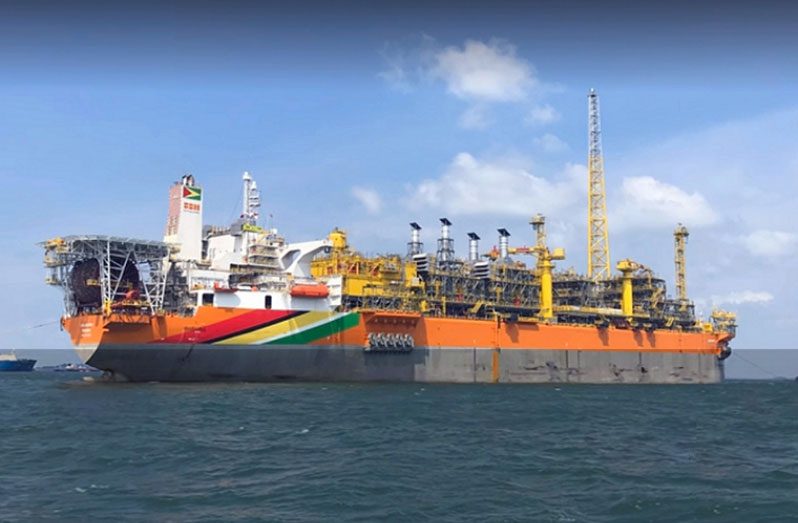AS a result of the revised provisions in the environmental permit for the Liza Phase One development at the Stabroek Block, ExxonMobil will be required to pay Guyana US$1.3 million (approximately G$279.5 million) for the excess flaring of gas.
It was reported recently that owing to the flaring of a significant amount of gas at the Liza Phase One development offshore Guyana, the Environmental Protection Agency (EPA) has modified the environmental permit for this project, leaving the operator, ExxonMobil, to stand the cost of any excess flaring.
The modified environmental permit includes revised terms and conditions relating to emissions reporting requirements, technical considerations for flaring, timelines for flaring events, and an obligation on the company to pay for the emission of carbon dioxide equivalent (CO2e) as a result of flaring in excess of these timelines.
Based on the terms of the new permit, as calculated by the EPA, ExxonMobil will have to pay US$30 per tonne of CO2e. At a press conference on Friday, Vice-President Bharrat Jagdeo, in responding to a question on when ExxonMobil will start paying fees for excess flaring, said the oil giant will be required to do so from the morning of May 26, 2021.
The EPA, in a statement issued on May 14, related that ExxonMobil, as a result of its flaring activity, was projected to exceed the 14 Billion Standard Cubic Feet (Bcf) of gas estimated by the Environmental Impact Assessment (EIA) to be flared for the project, on May 13, 2021.
“They will start paying fees for excess flaring from the morning of the 26th of May,” Vice-President Jagdeo said.
As he went on to explain, “Exxon says they’re flaring about 15 million cubics [cubic feet of gas per day] now, so that will be equivalent to about 1,152 tonnes of CO2 equivalent, or just below. And so, if you work out 1,100 by US$30 per tonne by 36 days, it should take us to about US$1.3M for the period they have applied for.”
On the question of whether fees charged for excess flaring would be recovered by ExxonMobil as part of cost oil, Mr. Jagdeo said the government’s position is, “No.”
It was reported that in Guyana’s case, oil companies are entitled to recover 75 per cent of their recoverable costs in a given month, as per the 2016 deal. Companies can only recover costs that are equal to the expenditures made to produce oil without any profit margin; it’s dollar for dollar spent. All of these expenditures are declared to the government regulator, and available for audit.
So, in relation to the excess flaring of gas, Jagdeo said the government has a method of disallowing it if the issue comes up for consideration among the stakeholders. Gas flaring became a cause for concern when the company resumed the activity recently, following intermittent periods of flaring since December 2019.
The resumption of flaring is a direct result of technical issues related to the flash-gas compressor aboard the Liza Destiny Floating Production Storage and Offloading (FPSO) vessel, which is servicing the Liza Phase One project.
The flash-gas compressor was repaired, upgraded and safely re-installed, but was slated to undergo a comprehensive three-phase testing programme to ensure full safety.
However, during the final stage of the three-phase testing programme, the company encountered a problem with the discharge silencer. A discharge silencer is used to attenuate noise produced by the expansion of air, steam or gas at elevated pressure to atmospheric pressure.
The contraption has since been sent to the U.S. for repairs and upgrades, as work continues in an effort to return operations to normal levels. Initially, as a result of the damaged discharge silencer, production at the Liza Destiny was initially reduced significantly, moving from 120,000 to 30,000 barrels per day, a decrease of 90,000 barrels.
But, amid the ongoing repairs, the company has started to ramp-up production, which has since moved from 30,000 barrels of oil per day to between 100,000 and 110,000 barrels per day, at a flare level of no more than 15 million standard cubic feet of gas per day (Mscfd).
Considering the challenges created by the defective equipment aboard the Liza Destiny, Minister of Natural Resources, Vickram Bharrat had said that ExxonMobil will replace the manufacturer of the compressor equipment to ensure there is no flaring during future projects.




.png)









